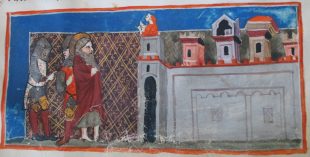In her public talk on January 16, 2019, Dr. Anne Leader discussed her DH project Digital Sepoltuario, which will offer students, scholars and the general public an online resource for the study of commemorative culture and medieval and renaissance Florence. Supported by the Institute for Advanced Technology in the Humanities (IATH) team at the University of Virginia, Digital Sepoltuario will chart the locations, designs and epitaphs of tombs made for Florentine families in sacred spaces across the city from about 1200 to about 1500, and then uses archival data to analyze social networks, patterns of patronage and markers of status in the late Middle Ages and Early Modern period.
While the project is not yet complete, it will include transcriptions, translations, photographs and analysis of fragile manuscripts, like registers that kept track of where different people were buried and records that indicate which tombs have been moved or destroyed. These documents demonstrate that tombs were frequently recycled from one family to another when lineages died out or when the family could no longer afford it. Because these records sometimes lost track of the owners of some tombs or the decorations faded away or disintegrated over time, there remains some uncertainty about some tombs’ owners that makes it impossible for historians to figure out now.

From these documents, scholars like Leader gain insight into why people chose certain tombs or churches as their final resting places. The tombstones are imbedded in the floors of churches in Florence, carpeting the churches with stone slabs that mark people’s final resting places and serving as reminders of everyone’s ultimate death. People would look down at the floor and contemplate what lay beneath the beautiful paintings and frescoes on the tombstones and within the churches, encouraging them to prepare for the final judgment and consider: am I ready for what’s to come?
By examining these records and incorporating them in a DH project, scholars can begin to answer questions about Florentines’ burial practices and ultimately about Florentines’ lives. Leader is interested in questions such as: How did Florentines decide on their final resting places, and how did they decide on the tombstones’ designs? So far, Leader noted that most people chose to be buried in their own parishes and close to their homes. However, she finds it interesting that increasing numbers of citizens requested burial elsewhere. This trend transformed the topography of Florence, causing tension within churches that relied on money from burying their dead and enriching some parishes while impoverishing others. Burial placement was one of the most important decisions Florentines would make, so considering why people wanted to be buried elsewhere and understanding the implications these decisions had on social status help scholars today decipher how early modern Europeans thought about burial and death. Digital Sepoltuario will make all of this possible.
This event was sponsored by Washington and Lee University’s Art History Department, the Digital Humanities Cohort and the Digital Humanities Mellon Grant.
-Jenny Bagger ’19, DH Undergraduate Fellow



 After a break for lunch of delicious chili and corn muffins, Professor Bufkin led the Cohort in exploring what having our own web domains entails and the options before us. She showed us how to use a CMS (Content Management System), which renders the desired content on the webpage, displaying it on a browser. Using a CMS, specifically WordPress, was extremely useful for our purposes because it was a simple way to get content on the web and the page up and running while working on HTML and CSS locally. WordPress allows web designers to use HTML in the text editor for posts or pages and customize additional CSS, allowing us to continue to experiment with HTML and CSS while we take advantage of the structure it provides for our websites without having to create our website from scratch. As we experimented with our websites, we considered important questions for web design, including what kind of pages do I need? How will users navigate my website? What kind of content will be on my webpage? Mostly photos or will I want writing? If I include a lot of writing, how should I use the white space on the page? What fonts should I use? The decisions and possibilities behind designing and customizing a webpage seemed endless.
After a break for lunch of delicious chili and corn muffins, Professor Bufkin led the Cohort in exploring what having our own web domains entails and the options before us. She showed us how to use a CMS (Content Management System), which renders the desired content on the webpage, displaying it on a browser. Using a CMS, specifically WordPress, was extremely useful for our purposes because it was a simple way to get content on the web and the page up and running while working on HTML and CSS locally. WordPress allows web designers to use HTML in the text editor for posts or pages and customize additional CSS, allowing us to continue to experiment with HTML and CSS while we take advantage of the structure it provides for our websites without having to create our website from scratch. As we experimented with our websites, we considered important questions for web design, including what kind of pages do I need? How will users navigate my website? What kind of content will be on my webpage? Mostly photos or will I want writing? If I include a lot of writing, how should I use the white space on the page? What fonts should I use? The decisions and possibilities behind designing and customizing a webpage seemed endless.


